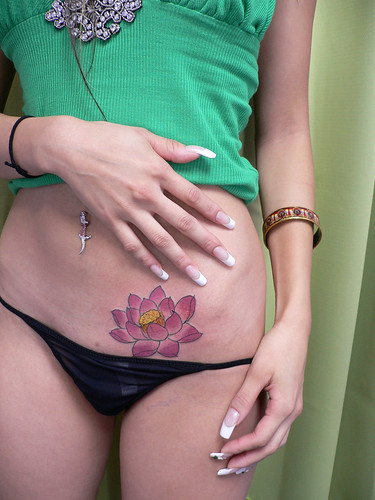
Tattoos, Tattoos, Tattoos... Take a look around you and you will observe that nearly every second man and women is sporting at least one tattoo these days. It seems that members of the young generation are, in ever increasing numbers, having tattoos etched on nearly every part of their bodies. The most common areas of the body for large tattoo designs are arms (both upper and lower regions) hands, and legs. Some more adventurous are having their tattoos on chest and upper back regions and some of the more daring are even having their scalp, face and neck tattooed. Since the start of the 1990’s the most popular of all places for tattoos among women (both young and mature alike), is on the lower back region slightly above the hips/waist.
The lower back tattoo design is quite often
 oblong in shape and is considered to enhance the curves and shapes of the female body. There are an untold number of reasons for this popularity, but probably the most common reason for women having a lower back tattoo is the fact that it is considered very attractive and sensual. In other words, a woman who displays such a tattoo believes that she becomes more attractive in the eyes of other people. Generally most women wish to be appealing to the opposite sex thus the explosion of the lower back tattoo!
oblong in shape and is considered to enhance the curves and shapes of the female body. There are an untold number of reasons for this popularity, but probably the most common reason for women having a lower back tattoo is the fact that it is considered very attractive and sensual. In other words, a woman who displays such a tattoo believes that she becomes more attractive in the eyes of other people. Generally most women wish to be appealing to the opposite sex thus the explosion of the lower back tattoo!
The History And Origins of the Lower Back Tattoo
While the lower back tattoo has re-emerged in popularity over the last few years, it is certainly not a new design. In fact lower back tattoos have been around for hundreds of years. The origin of lower back tattoo is actually connected to ancient religions and spiritual rituals. In ancient times, the lower part of the back was considered as the storage place of a person’s spiritual energy. This is quite similar to the notion of the chi force and meridian fields that are common to eastern cultures. Additionally, the concept of lower back energy is also found in certain styles of Yoga. It is therefore not surprising that this concept shares similar traits with other eastern religions as
 the practice of Yoga played an influential role within many types of eastern religions.
the practice of Yoga played an influential role within many types of eastern religions.Historically, the lower back area emerged as a popular place to show off tattoos, as it was believed the tattooing in this region of the body would assist in the release and subsequent harnessing of a person’s internal energy. Regrettably much of the history supporting the lower back tattoo has been lost to all but the most knowledgeable scholars of the subject.
Many of the women wearing a lower back tattoo design today are not necessarily familiar with the origins and the unique history and significance of this type of tattoo. It is not imperative to understand the complete history behind the lower back tattoo, however, some knowledge of its origins may well add a unique aspect and significance to the tattoo as well as helping to explain to others why you chose this particular style of tattoo.









